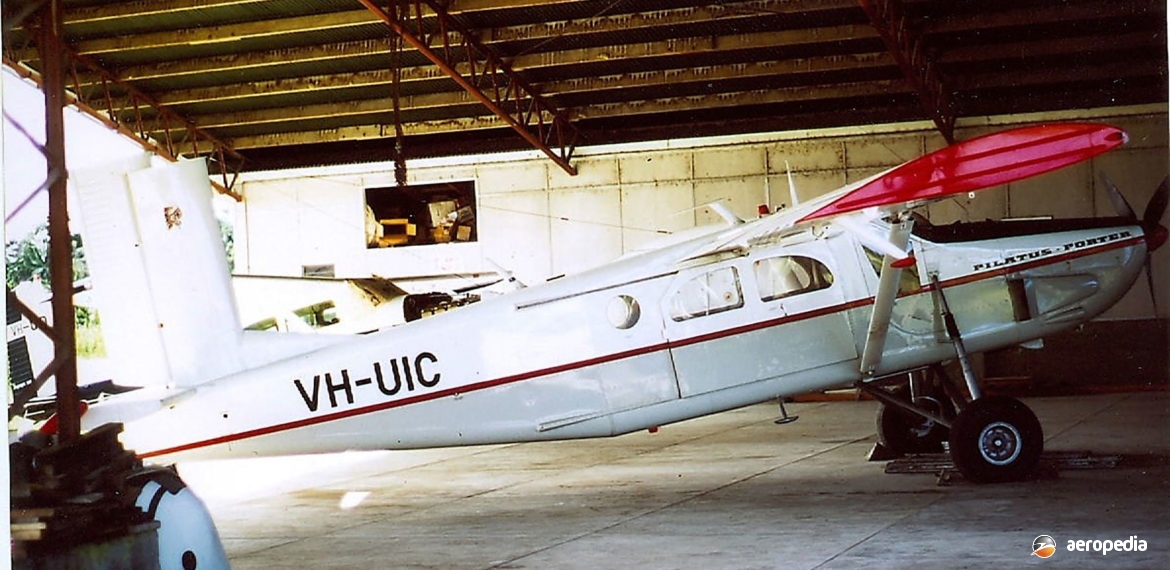Photograph:
Pilatus Porter PC-6/H2 VH-UIC (c/n 660) at Wirui/Wewak, Papua New Guinea on 31 December 1972 (Nigel Daw)
Country of origin:
Switzerland
Description:
General purpose utility transport
Power Plant:
One 261 kw (350 hp) Lycoming IGO-540-AIA six-cylinder horizontally-opposed air-cooled engine
Specifications:
- Wingspan: 15.20 m (49 ft 10½ in)
- Length: 10.21 m (33 ft 5½ in)
- Height: 3.2 m (10 ft 6 in)
- Wing area: 28.50 m² (306.8 sq ft)
- Max speed: 233 km/h (145 mph)
- Economical cruising speed at 60% power at 1,981 m (6,500 ft): 187 km/h (116 mph)
- Rate of climb at sea level: 259 m/min (850 ft/min)
- Service ceiling: 4,481 m (14,700 ft)
- Range: 1,497 km (930 miles)
- Empty weight: 1,070 kg (2,360 lb)
- Loaded weight: 1,960 kg (4,320 lb)
History:
Pilatus Flugzeugwerke was formed in December 1939 under the leadership of M E Buehrle, the Swiss industrialist and owner of the Oerlikon company. After a number of designs the PC-6 was developed. Flown for the first time on 4 May 1959, the PC-6 Porter was a six-seat multi-purpose utility transport designed for both military and commercial applications, a pre-production series of five aircraft, including the prototype, being completed. Designed to compete with the Dornier DO-27 and de Havilland DHC-2 Beaver, the Porter was reasonably successful but found its niche in the market when it was fitted with a turboprop engine.
The PC-6 owed much to the experimental P-4 and was of all-metal construction. It could carry up to 454 kg (1,000 lb) of cargo; it could operate as an ambulance, being able to accommodate two stretchers; and it could be fitted with wheels, floats, or skis. Two engines were initially available, Lycoming’s providing 205 kw (275 hp) or 254 kw (340 hp). Designed and built by Pilatus Aircraft Works Ltd of Stans, Switzerland, the Porter was designed to operate over rugged terrain and into small landing strips in areas where good control at low speeds, with very short take-offs and landings, is required. Able to carry freight, it had a capacious cabin with large double doors to accept a wide variety of loads.
The aircraft was a high-wing monoplane, the wing being constructed in two halves, each attached to a centre-section integral with the fuselage. It had a single main spar of I-section and an auxiliary rear spar to carry the ailerons and flaps. The wing was fitted with slotted flaps, these contributing to its low-speed performance. A development of the Porter was the PC-8 Twin Porter, which made its first flight on 28 November 1967 and which was powered by two 216 kw (290 hp) Lycoming IO-540-G1B5 engines.
Only one example of the piston-engined Porter has been registered in this region. VH-UIC, a PC-6/H-2 (c/n 660), was built in 1967 with a 261 kw (350 hp) Lycoming engine. Initially registered HB-FDB in 1968 to Pilatus Flugzeugwerke AG of Stans, it made a demonstration tour of North Africa on behalf of Pilatus in 1969. It was sold and registered to Wirui Air Services, the operating company for the Catholic Mission of the Divine Word, Wewak, NG in 1972, becoming VH-UIC on 21 April 1972. On 15 May 1974 it was transferred to the Papua New Guinea register, becoming P2-UIC with the same owner and operating company. It was later sold to Talair Pty Ltd of Goroka, becoming P2-SEZ on 8 March 1978 but on 20 September 1979 it was damaged in an accident and broken up for parts.
It is reported at some stage it was re-configured to Turbo Porter configuration by the installation of a turbine engine. It was withdrawn from service on 20 September 1979 and returned to Switzerland where it became HB-FDB again. It was damaged in an accident in August 1985 and was reduced to spares, being used in the rebuild of PC-6 airframe c/n 551.
In 2004 an example was imported to New Zealand where work commenced on making it airworthy at the Pioneer Aero Restoration facility. The registration ZK-PCI was allotted and it operated with Highland Air. At the time this machine was the seventh oldest Porter flying in the world. It was built at Stans in 1961 and became HB-FBA in May 1962. It was fitted out as a corporate aircraft with wheel-skis and had a 254 kw (340 hp) GSO-480 engine. In 1965 it was converted to PT-6A-H2 configuration with a 390 kw (523 shp) Turbomeca Astazou IIE turboprop and went to an American company as XW-PCI, seeing service in Laos.
On 15 August 1970 it was fitted with a Pratt & Whitney PT6A-20 engine of 410 kw (550 shp) and continued to fly in the secret war in Laos and Cambodia, eventually in September 1974 becoming N62158 and going to Thailand where it was operated by the Thai Army. It seems it went to the United Kingdom and in 2015 was stolen, the airframe subsequently being broken up by the thieves and sold for parts.

